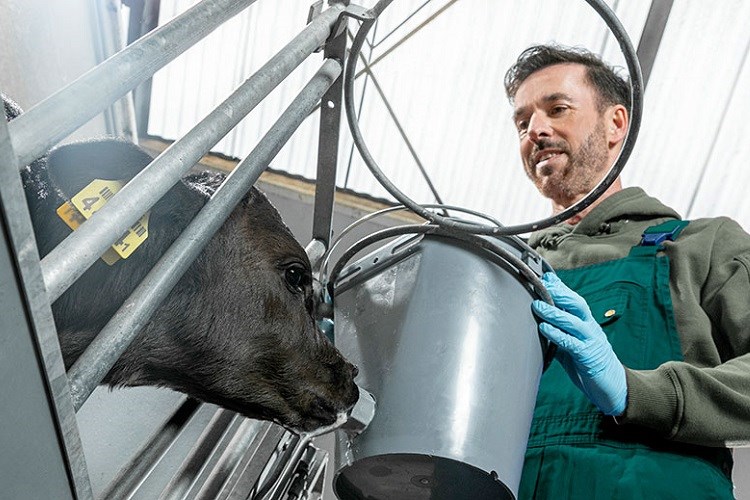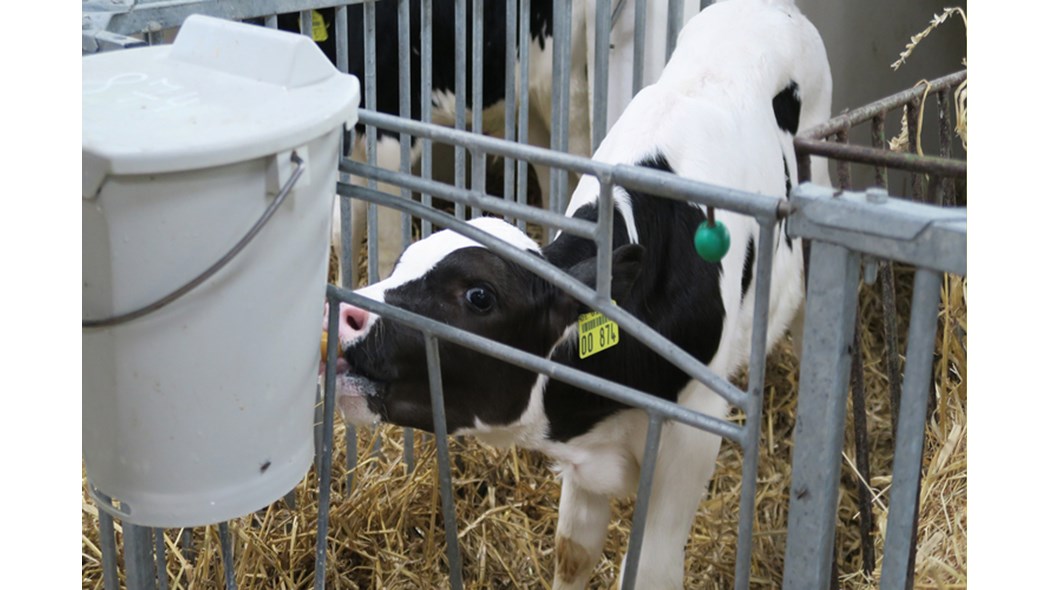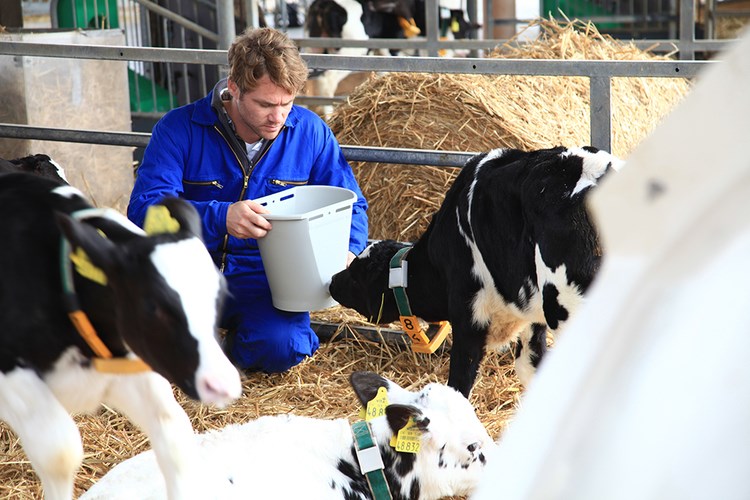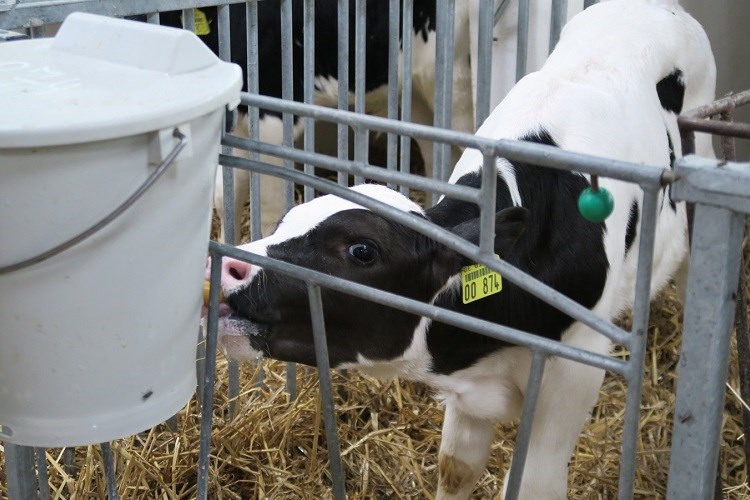
Key takeaways from the research
-
Calves fed 8 litres of calf milk replacer per day had greater pre-weaning ADG than those fed 6 litres or 4 litres.
-
Calves fed 4 litres of calf milk replacer per day were older at conception than those fed 6 litres or 8 litres.
-
Calves fed 8 litres of calf milk replacer per day had a reduction of insulin sensitivity at 42 days of age but impaired glucose tolerance did not persist after weaning.

Intensive feeding schedules improve the growth and fertility of calves without long-term negative effects on glucose tolerance
Many studies have proven that feeding dairy calves higher amounts of milk during the pre-weaning phase has many benefits, such as an increase in pre-weaning average daily gain[1] and reduced age at first calving[2]. However, calves given higher milk or calf milk replacer allowances have been reported to have increased blood insulin to glucose ratios[3] and have become insulin resistant at an early age[4]. The risk to develop these problems increases if calves are fed twice a day only, which is common in commercial herds, as the metabolic capacity could be overwhelmed. In her PhD thesis for the Universitat Autonoma de Barcelona, Dr. Christina Yunta studied the advantages and disadvantages of elevated planes of nutrition[5].
Study design
A total of 120 female Holstein calves were included in the study and were randomly assigned to one of three groups and fed: 2, 3 or 4 litres of calf milk replacer twice daily. Calves had access to starter and water ad libitum. Calf milk replacer and starter feed intake were recorded daily from days 2 to 70. Calves were weighed at days 0, 35, 63 and 300 and the average daily gain was calculated. All calves were weaned at day 63, using step-down methods which varied in amount and timing depending on milk level in the treatment group. Glucose tolerance tests were performed at days 42, 86 and 300 on 15 randomly selected heifers per group.
Growth and reproductive performance
During the first month of life, total dry matter intake was greatest for 8L calves. The 6L and 8L calves consumed less starter feed than 4L calves. At 35 days, the 8L calves had the highest ADG (752 g/d) followed by the 6L calves (564 g/d) and the 4L calves (484 g/d). While there was a slight increase in growth of 4L calves during weaning, 8L calves were still 4 kg heavier than calves in both the 6L and 4L groups at day 63. On day 300, the 8L calves were 12 kg heavier than the 4L calves.
The rate of conception was not different between the groups, but the age at conception was higher for the 4L calves. Larger sample sizes may be required to come to a final conclusion. It seems that calves fed large amounts of milk or calf milk replacer reach puberty and pregnancy at an earlier age.
Glucose metabolism and insulin sensitivity
Interestingly, the amount of calf milk replacer fed had different effects on glucose metabolism in the short-term compared to the medium-term. While at 42 days the 8L calves needed a greater amount of insulin to control glycemia than the 6L and 4L calves, these differences disappeared at 84 days. At 300 days, the situation was reversed, with the 8L calves needing lower amounts of insulin than both the 4L and 6L calves to control glycemia during a glucose tolerance test. For the 8L calves, the negative effects on glucose metabolism were completely transitory.
Conclusions
References
[1] Terré, M., Tejero, C., Bach, A. Long-term effects on heifer performance of an enhanced-growth feeding programme applied during the preweaning period. J. Dairy Res. 2009; 76:331–339.
[2] Bar-Peled, U., Robinzon, B., Maltz, E., Tagari, H., Folman, Y., Bruckental, I., Voet, H., Gacitua, H., Lehrer, A.R. Increased weight gain and effects on production parameters of Holstein heifer calves that were allowed to suckle from birth to six weeks of age. J. Dairy Sci. 1997: 80:2523–2528. And Moallem, U., Werner, D., Lehrer, H., Zachut, M., Livshitz, L., Yakoby, S., Shamay, A. Long-term effects of ad libitum whole milk prior to weaning and prepubertal protein supplementation on skeletal growth rate and first-lactation milk production. J. Dairy Sci. 2010; 93: 2639–2650.
[3] Hammon, H.M., Schiesseir, G., Nussbaum, A., Blum, J.W. Feed intake patterns, growth performance, and metabolic and endocrine traits in claves fed unlimited amounts of colostrum and milk by automate, starting in the neonatal period. J. Dairy Sci. 2002; 85:3352–3362. And Terré, M., Tejero, C., Bach, A. Long-term effects on heifer performance of an enhanced-growth feeding programme applied during the preweaning period. J. Dairy Res. 2009; 76:331–339.
[4] Hostettler-Allen, R.L., Tappy, L., Blum, J.W. Insulin resistance, hyperglicemia, and glucosuria in intensively milk-fed calves. J. Anim. Sci. 1994; 72:160–173. Hugi, D., Bruckmaier, R.M., Blum, J.W. Insulin resistance, hyperglycemia, glucosuria, and galactosuria in intensively milk-fed calves: dependency on age and effects of high lactose intake. J. Anim. Sci. 1997; 75:469–482. And Bach, A., Domingo, L., Montoro, C., Terré, M. Short communication: insulin responsiveness is affected by the level of milk replacer offered to young calves. J. Dairy Sci. 2013; 96:4634–4637.
[5] Yunta, C. (2015) Short- and medium-term changes in performance and metabolism of dairy calves offered different amounts of milk replacer (Unpublished doctoral dissertation). Universitat Autonoma de Barcelona, Spain.






